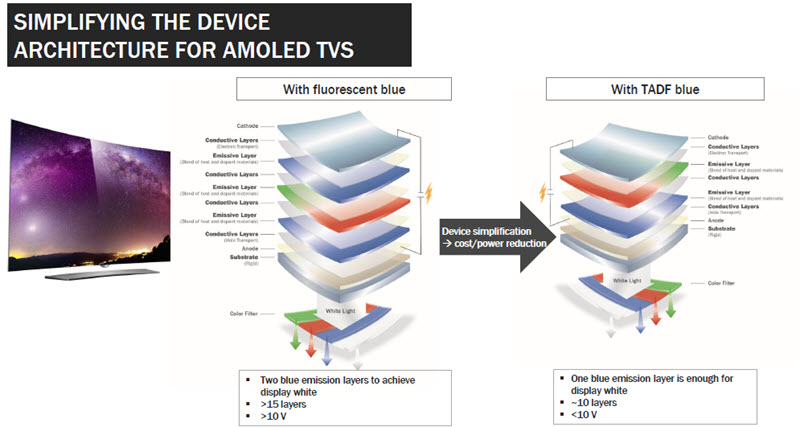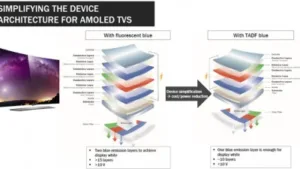Andreas Haldi is from Cynora of Germany, which makes TADF. an OLED material, that is claimed to have better efficacy than existing phosphorescent materials. He said that he had heard mention of Google as a possible investor in LGD to get access to OLED.
Power consumption is a critical issue in mobile devices. If you look at a Samsung smartphone, the green is the smallest pixel, the red is bigger and the biggest blue. That’s because there are good red and green materials, but no high efficiency blue OLED materials. Cynora doesn’t use phosphorescent material but uses TADF concepts. That means you don’t have a problem with phosphorescent patents (most belonging to UDC – Man. Ed.). The company has been working for six years on TADF materials. There are a number of advantages beyond the better output of TADF materials. OLED needs around 10V to drive and also need multiple layers. TADF means lower voltages and a simplification of the device structure, which should reduce the cost.
 TADF is said to be simpler than OLED in device structure
TADF is said to be simpler than OLED in device structure
Haldi said that Cynora has new results for its materials that are meeting, or close to meeting, the numbers needed by customers. Customers would like to see >15% EQE and Cynora is currently at 15%. Customers want >100 hours at LT97 at 700cd/m² – Cynora has 90 hours. Colour desired is 460 at 60nm purity, but Cynora can do 470nm with 62nm so the company believes that it is very close to meeting real customer requirements. Therefore, it plans to offer commercial blue material from the end of 2017. It has done this because it has 97 experts and has a fabless model, so Cynora will use a partner for manufacturing. (Cynora didn’t include these numbers in its PPT, so the numbers quoted are from our notes.)
The company has more than 100 patents.
The next step will be to add red and green and will be one or two years later (red in 2018, green in 2019). The company believes its materials can be used in inkjet printing deposition processes, which would mean potential access to the TV panel market.
The firm is currently close to closing a financial round and plans another in around 18 months.
Analyst Comment
UDC’s Mike Hack, during the panel session said that he thought that Cynora might have more difficulty than it anticipates to move the wavelength of its blue material. (BR)

